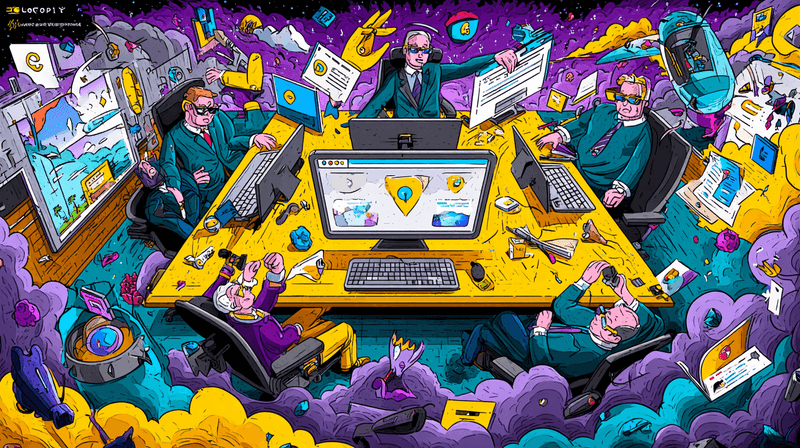The Enshitification Death Spiral

The Enshitification Death Spiral
Once upon a time, software was built to solve problems. It was a tool, a craft, a digital Swiss Army knife forged by idealistic engineers who believed in the quaint notion of “user value.” But that was before the Great Enshitification, a process so insidious, so inevitable, that it now rivals entropy as the universe’s most reliable force.
The Golden Age: When Software Was Merely Mediocre
Let’s set the scene. It’s 2010. You download a text editor. It opens in under a second. It doesn’t ask for your email, your phone number, or the name of your first pet. It just works. Sure, it crashes if you try to open a 2GB log file, but that’s a feature, not a bug. You feel a sense of control, a fleeting illusion that you, the user, matter.
But then, somewhere in a boardroom, a Product Manager utters the fateful words: “How can we increase engagement?” And thus, the cycle begins.
Step One: Add Features Nobody Asked For
The first sign of enshitification is the relentless march of features. Your once streamlined text editor now boasts a built-in cryptocurrency wallet, AI-powered emoji suggestions, and a social feed. The settings menu has more tabs than Chrome after a week of procrastination. Each update brings a new pop-up, a new onboarding tour, and a new reason to yearn for Vim.
Why? Because engagement metrics must go up. Because someone, somewhere, decided that what users really want is a notification every time a stranger in Belarus highlights a line of their code.
Step Two: Monetize the Misery
But features alone do not pay the bills. Enter the monetization team, wielding the dark arts of subscription models and microtransactions. Suddenly, basic functionality is locked behind a paywall. Want to save your file? That’s $4.99 a month. Want to use dark mode? That’s part of the “Pro” tier. Want to opt out of data collection? Sorry, that’s not available in your region.
The software, once a tool, is now a slot machine. Every click is an opportunity to upsell, cross-sell, or just plain sell your data to the highest bidder. The user is no longer a customer, they’re a revenue stream, a metric, a line on a quarterly report.
Step Three: Optimize for Stakeholders, Not Users
As the user experience deteriorates, the software’s true audience emerges: stakeholders. Every design decision is filtered through the lens of “shareholder value.” The roadmap is dictated by quarterly earnings calls, not user feedback. The bug tracker is a graveyard of “won’t fix” tickets, each one a testament to the triumph of business over utility.
The result? A product that is technically functional, but spiritually bankrupt. It does everything except what you actually need. It’s the digital equivalent of a Swiss Army knife with 47 bottle openers and no blade.
Step Four: The Death Spiral
By now, users are fleeing in droves. The forums are ablaze with complaints. The subreddit is a wasteland of memes and migration guides. But the enshitification process is self-sustaining. As the user base shrinks, the pressure to monetize the remaining loyalists increases. More ads, more pop-ups, more “engagement opportunities.”
Eventually, the software collapses under the weight of its own mediocrity. The company pivots to “AI-powered blockchain solutions for the metaverse,” and the cycle begins anew.
Real-World Case Studies (Names Changed to Protect the Guilty)
- Chirper: Once a microblogging haven, now a labyrinth of algorithmic feeds, sponsored content, and “premium” blue checkmarks. The only thing chirping is the sound of users exporting their data.
- FaceSpace: From college directory to surveillance capitalism’s crown jewel. Now featuring more suggested reels than actual friends.
- Slackr: The team chat app that became a platform, then a marketplace, then a productivity black hole. Every new feature is a reason to long for IRC.
The Existential Wisdom of Enshitification
Why does this happen? Because in the tech industry, success is measured not by user satisfaction, but by growth. Growth at all costs. Growth until the product is a bloated, unusable husk, and the only thing left to optimize is the exit strategy.
And so, dear reader, the next time your favorite app asks you to “rate your experience” after forcing you through a 12-step onboarding process, remember: you are witnessing the enshitification in real time. Cherish the moment. It’s the only thing they haven’t monetized … yet.
In the end, all software aspires to become a platform, all platforms aspire to become a monopoly, and all monopolies aspire to become utterly, irredeemably enshittified. It’s not a bug. It’s a feature.